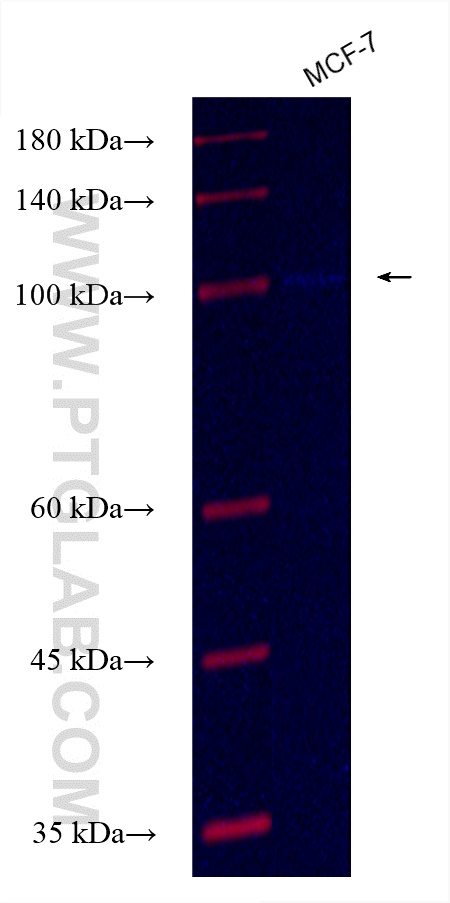CoraLite® Plus 750-conjugated TMEM132E Recombinant antibody
TMEM132E Recombinant Antibody for WB
Host / Isotype
Rabbit / IgG
Reactivity
Human
Applications
WB
Conjugate
CoraLite® Plus 750 Fluorescent Dye
CloneNo.
230525E12
Cat no : CL750-82983-2
Synonyms
Validation Data Gallery
Tested Applications
| Positive WB detected in | MCF-7 cells |
Recommended dilution
| Application | Dilution |
|---|---|
| Western Blot (WB) | WB : 1:1000-1:4000 |
| It is recommended that this reagent should be titrated in each testing system to obtain optimal results. | |
| Sample-dependent, Check data in validation data gallery. | |
Product Information
CL750-82983-2 targets TMEM132E in WB applications and shows reactivity with Human samples.
| Tested Reactivity | Human |
| Host / Isotype | Rabbit / IgG |
| Class | Recombinant |
| Type | Antibody |
| Immunogen | TMEM132E fusion protein Ag26772 |
| Full Name | transmembrane protein 132E |
| Calculated Molecular Weight | 116 kDa |
| Observed Molecular Weight | 116 kDa |
| GenBank Accession Number | NM_001304438 |
| Gene Symbol | TMEM132E |
| Gene ID (NCBI) | 124842 |
| Conjugate | CoraLite® Plus 750 Fluorescent Dye |
| Excitation/Emission Maxima Wavelengths | 755 nm / 780 nm |
| Form | Liquid |
| Purification Method | Protein A purification |
| Storage Buffer | PBS with 50% Glycerol, 0.05% Proclin300, 0.5% BSA, pH 7.3. |
| Storage Conditions | Store at -20°C. Avoid exposure to light. Stable for one year after shipment. Aliquoting is unnecessary for -20oC storage. |
Background Information
Transmembrane protein 132E (TMEM132E) is a member of the TMEM132 family which also include TMEM132A, TMEM132B, TMEM132C, TMEM132D (PMID: 29088312). The gene of TMEM132E is located within the DFNB99 locus on chromosome 17q12 and is highly expressed in the inner ear and other tissues including brain, kidney, lung, liver, spleen, heart, small intestine, colon, thymus, and stomach (PMID: 31656313). A variant of TMEM132E has been associated with autosomal-recessive nonsyndromic hearing loss DFNB99 (PMID: 25331638).
Protocols
| Product Specific Protocols | |
|---|---|
| WB protocol for CL Plus 750 TMEM132E antibody CL750-82983-2 | Download protocol |
| Standard Protocols | |
|---|---|
| Click here to view our Standard Protocols |


